
St Quivox is a small Scottish village north of Ayr and east of Prestwick. It lies on the B7035 east of the A77.

St Quivox is a small Scottish village north of Ayr and east of Prestwick. It lies on the B7035 east of the A77.
The uniquely named village is said to be a corruption either of St Kevoca, St Kevoch or St Kennocha. [1] It is thought to have been a Christian settlement since the 8th century. It was previously known as Sanchar (Sanquhar) in Kyle, and was renamed after its church (and its saint) in the Middle Ages. [2]
Auchincruive House and church lie within the parish boundary. Auchincruive church was described as a "rectory" in 1208 and from 1221 to 1238 was linked to a Gilbertine Priory at Dalmilling or Dalmulin, the only Gilbertine Priory in Scotland, but from 1238 to 1560 was under the control of Paisley Abbey before becoming a parish church. [3]
After the Reformation the church came under the patronage of Alan, 4th Lord Cathcart who then owned Auchincruive House and he instructed a repair and remodelling of the church to Protestant standards in 1595. The church was substantially rebuilt in the 18th century. [4]
The Scottish Agricultural College was built in the parish in 1927. [5]
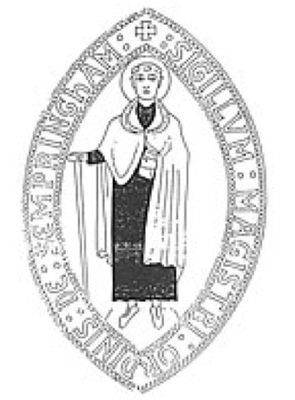
The Gilbertine Order of Canons Regular was founded around 1130 by Saint Gilbert in Sempringham, Lincolnshire, where Gilbert was the parish priest. It was the only completely English religious order and came to an end in the 16th century at the time of the Dissolution of the Monasteries. Modest Gilbertine revivals have taken place in the late 20th and early 21st centuries on three continents.

Ceres is a village in Fife, Scotland, located in a small glen approximately 2 miles (3 km) over the Ceres Moor from Cupar and 7 mi (11 km) from St Andrews. The former parish of that name included the settlements of Baldinnie, Chance Inn, Craigrothie, Pitscottie and Tarvit Mill.

Everdon is a village in West Northamptonshire in England, some 3 miles (4.8 km) south of Daventry. The population of the civil parish at the 2011 census was 356.

Sempringham is a hamlet in the South Kesteven district of Lincolnshire, England. It is situated 2 miles (3.2 km) south from the A52 road, 12 miles (19 km) east from Grantham and 8 miles (13 km) north from Bourne. The hamlet is in the civil parish of Pointon and Sempringham, and on the western edge of the Lincolnshire Fens, the closest village being Billingborough, 0.5 miles (0.80 km) to the north on the B1177 road. Sempringham is noted as the home of Gilbert of Sempringham, the son of the lord of the manor. Gilbert is the only English Saint to have founded a monastic order, the Gilbertines.

Mauchline is a town and civil parish in East Ayrshire, Scotland. In the 2001 census Mauchline had a recorded population of 4,105. It is home to the National Burns Memorial.
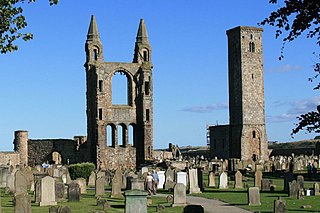
The Cathedral of St Andrew is a ruined cathedral in St Andrews, Fife, Scotland. It was built in 1158 and became the centre of the Medieval Catholic Church in Scotland as the seat of the Archdiocese of St Andrews and the Bishops and Archbishops of St Andrews. It fell into disuse and ruin after Catholic mass was outlawed during the 16th-century Scottish Reformation. It is currently a monument in the custody of Historic Environment Scotland. The ruins indicate that the building was approximately 119 m (390 ft) long, and is the largest church to have been built in Scotland.
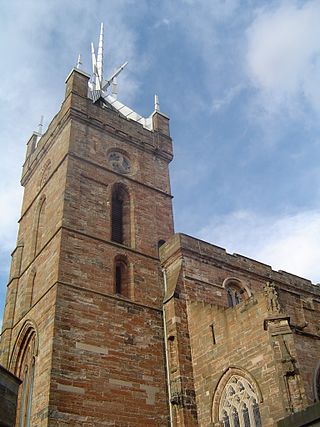
St. Michael's Parish Church is one of the largest burgh churches in the Church of Scotland. It is one of two parishes serving the West Lothian county town of Linlithgow, the other being St. Ninian's Craigmailen. St Michael is the town's patron saint; the town's motto is "St Michael is kinde to strangers".

Arbuthnott is a village and parish in the Howe of the Mearns, a low-lying agricultural district of Aberdeenshire, Scotland. It is located on the B967, east of Fordoun and north-west of Inverbervie. The nearest railway station is Laurencekirk.

Urquhart is a small village in Moray, Scotland. It is approximately 5 miles (8 km) east of Elgin, between the villages of Lhanbryde and Garmouth. Urquhart had a population of 420.
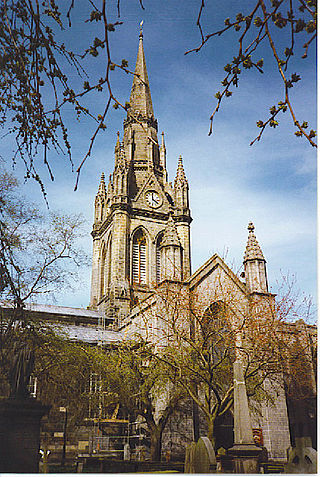
The Kirk of St Nicholas is a historic church located in the city centre of Aberdeen, Scotland. Up until the dissolution of the congregation on 31 December 2020, it was known as the "Kirk of St Nicholas Uniting". It is also known as "The Mither Kirk" of the city. As of 1 January 2021, the building falls under the care and maintenance of the General Trustees of the Church of Scotland.

The Collegiate Church of St Mary the Virgin is a Church of Scotland parish church in Haddington, East Lothian, Scotland.
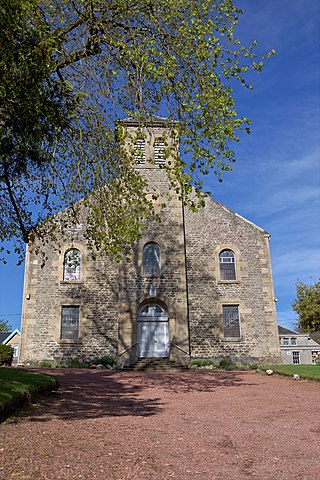
Abbeygreen Church is a congregation of the Free Church of Scotland in the small town of Lesmahagow, Lanarkshire. As a Christian congregation, it is presbyterian and reformed; holding the Word of God, the Holy Bible, as the supreme rule of life and doctrine and the Westminster Confession of Faith as a sub-ordinate standard, which helps explain the doctrines of the Christian faith. Being Presbyterian, it serves as part of the Free Church of Scotland Presbytery of Glasgow and seeks to faithfully serve God in Lesmahagow and the surrounding area. Having a missional outlook it is involved with a number of missionary organizations including, but not only, UFM Worldwide and Rose of Sharon Ministries, and helps with the organization and support of the Scottish Reformed Conference.

Sixhills is a village in the West Lindsey district of Lincolnshire, England, about 3 miles (4.8 km) south-east from Market Rasen. It lies just south of the A631 between Market Rasen and Ludford. It is in the civil parish of North Willingham.

Portmoak is a parish in Kinross-shire, Scotland. It consists of a group of settlements running north to south: Glenlomond, Wester Balgedie, Easter Balgedie, Kinnesswood, Kilmagadwood and Scotlandwell.
Alvingham Priory was a Gilbertine priory in St. Mary, Alvingham, Lincolnshire, England. The Priory, established between 1148 and 1154, was a "double house", where religious of both sexes lived in two separate monasteries. They did not commonly communicate with one another, and there was an internal wall dividing their priory church. The superior of every Gilbertine house was the prioress, the prior being really an official of her house.
St. Katherine's Priory also known as The Priory of Saint Katherine without Lincoln was a Gilbertine priory of Canons Regular on the Fosse Way just outside the walls of Lincoln, England. The Priory ran the Hospital of St Sepulchre, probably the first hospital in the city.

Sempringham Priory was a priory in Lincolnshire, England, located in the medieval hamlet of Sempringham, to the northwest of Pointon. Today, all that remains of the priory is a marking on the ground where the walls stood and a square, which are identifiable only in aerial photos of the vicinity. However, the parish church of St Andrew's, built around 1100 AD, is witness to the priory standing alone in a field away from the main road.
George Reid (1692–1763) was a minister of the Church of Scotland, who served as Moderator of the General Assembly in 1755.
William McQuhae or M'Quhae (1737–1823) was a senior Scottish clergyman in the Church of Scotland who by the time of his death was Father of the Church. He is one of the few persons to have declined the offer to be Moderator of the General Assembly. He was a member of the New Light Movement. He is mentioned within the poems of Robert Burns.